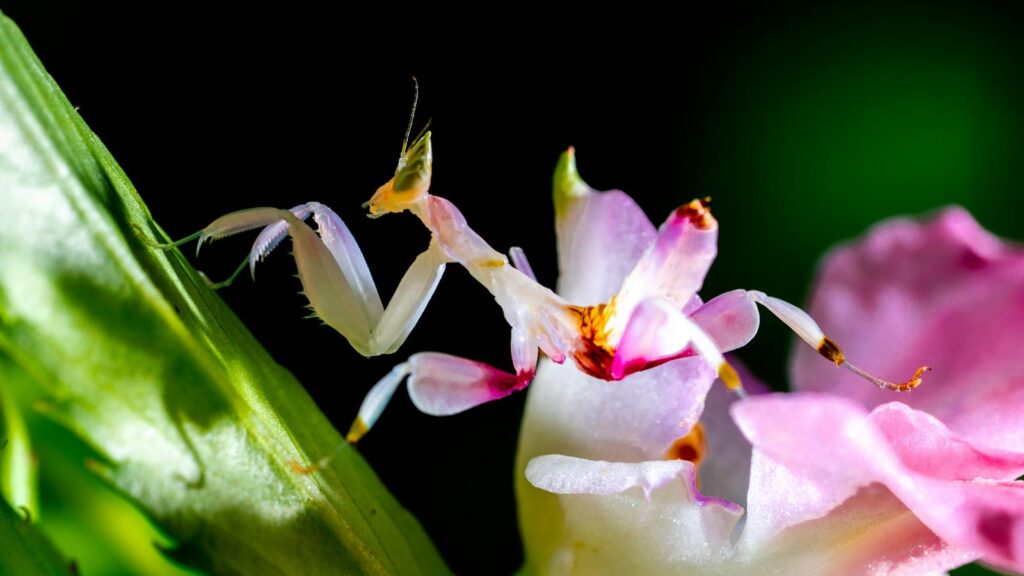Deep in the rainforests of Southeast Asia, something extraordinary is happening. A delicate pink and white flower sways gently in the breeze, its petals catching the morning light like precious gems. But this isn’t a flower at all — it’s one of nature’s most cunning predators, perfectly disguised and waiting for the perfect moment to strike. The orchid mantis represents evolution’s most stunning example of aggressive mimicry, where beauty becomes a deadly weapon. This remarkable insect has fooled scientists, photographers, and countless prey for centuries, proving that in nature, appearances can be devastatingly deceiving.
The Master of Disguise

The orchid mantis (Hymenopus coronatus) doesn’t just resemble a flower — it embodies botanical perfection. Its body segments have evolved into petal-like structures, complete with the delicate pink and white coloration that makes real orchids so captivating. The mantis can even adjust its color intensity based on humidity, temperature, and lighting conditions, ensuring its disguise remains flawless throughout the day.
What makes this mimicry truly extraordinary is its three-dimensional quality. Unlike flat camouflage patterns found in other insects, the orchid mantis has developed actual physical structures that mirror flower petals. Its legs have broadened into flat, petal-like appendages, while its body segments curve and fold to create the illusion of a blooming orchid. This isn’t just surface-level mimicry — it’s architectural deception at its finest.
The Deadly Beauty Trap
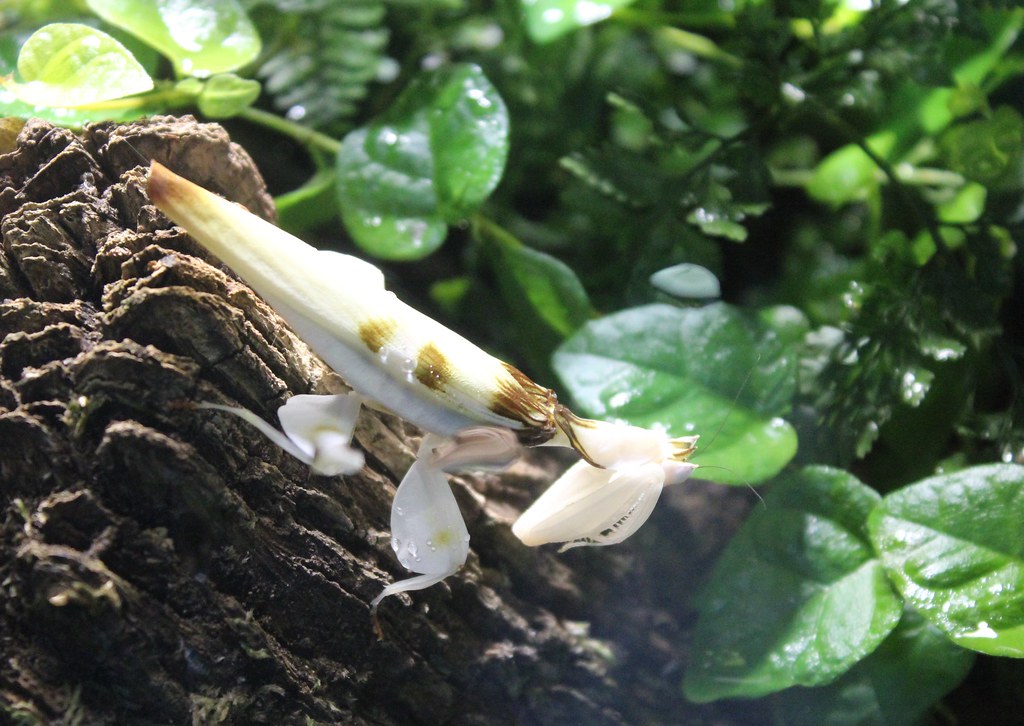
This stunning disguise serves a sinister purpose that would make any horror movie villain envious. The orchid mantis uses its flower-like appearance to lure unsuspecting pollinators directly into its grasp. Bees, butterflies, and other insects approach what they believe to be a nectar-rich flower, only to find themselves face-to-face with lightning-fast raptorial forelegs.
The mantis positions itself strategically on real flowers or plants, becoming nearly indistinguishable from the actual blooms around it. When prey comes within striking distance, the mantis can extend its forelegs and capture victims in less than 0.3 seconds. This split-second attack is so fast that high-speed cameras are needed to capture the full sequence of the deadly embrace.
Evolution’s Masterpiece
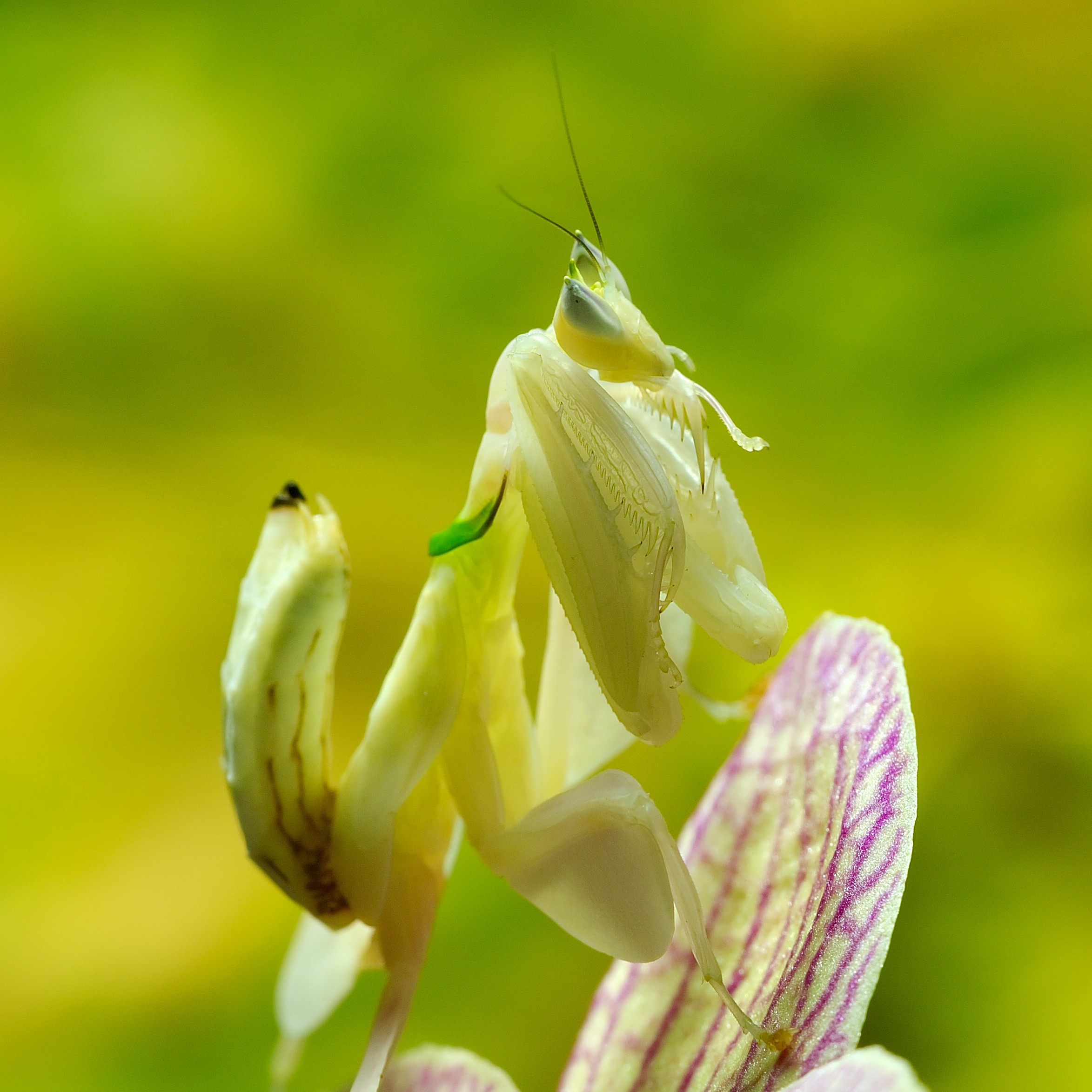
The orchid mantis represents millions of years of evolutionary refinement, where natural selection has sculpted every detail for maximum deception. Scientists believe this species evolved alongside the flowering plants it mimics, developing increasingly sophisticated disguises as flowers became more complex and diverse. The mantis didn’t just adapt to look like any flower — it specifically evolved to mimic the most attractive and rewarding flowers in its environment.
This co-evolutionary arms race has produced one of nature’s most perfect examples of aggressive mimicry. Unlike defensive mimicry, where animals disguise themselves to avoid predators, aggressive mimicry involves predators disguising themselves to attract prey. The orchid mantis has taken this strategy to unprecedented levels, becoming a living, breathing floral fraud that operates with ruthless efficiency.
The Science Behind the Illusion
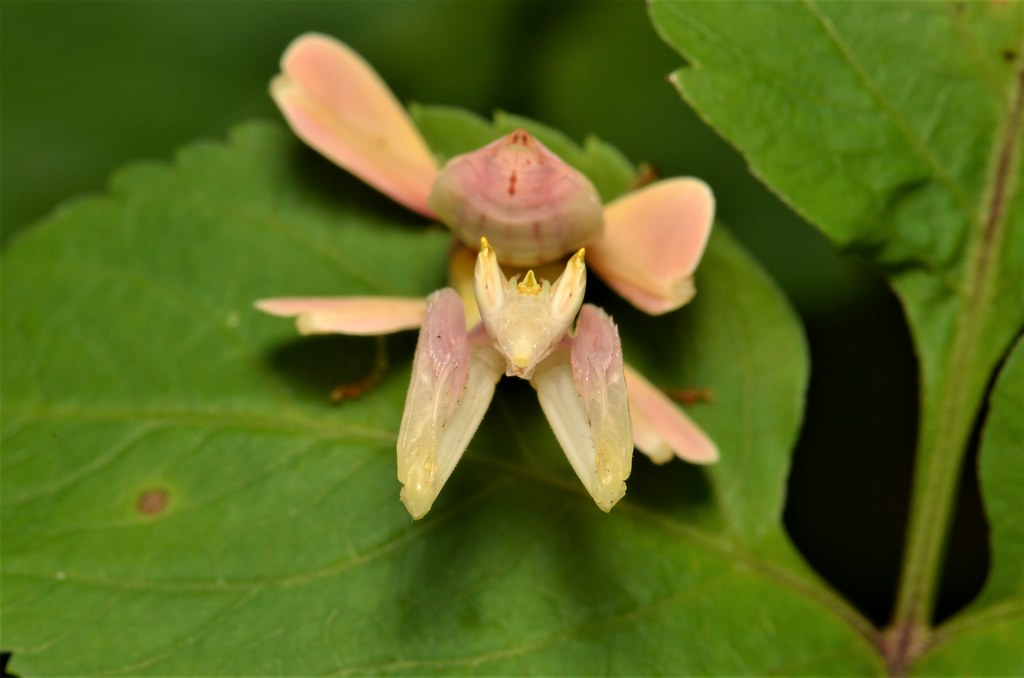
Recent research has revealed the sophisticated mechanisms behind the orchid mantis’s incredible disguise. The insect’s coloration comes from specialized cells called chromatophores, which contain pigments that can be concentrated or dispersed to change color intensity. Additionally, the mantis has microscopic structures on its exoskeleton that reflect light in ways that mimic the waxy surface of real flower petals.
Studies using ultraviolet photography have shown that the orchid mantis’s disguise is even more convincing than previously thought. Many insects, including bees and butterflies, can see ultraviolet light patterns that are invisible to human eyes. The orchid mantis has evolved UV-reflective properties that perfectly match those of real flowers, making its disguise effective across the entire spectrum of insect vision.
Temperature regulation also plays a crucial role in maintaining the illusion. The mantis can adjust its body temperature to match that of surrounding flowers, ensuring that heat-sensitive prey don’t detect any temperature differences that might reveal its true nature.
Hunting Strategies and Techniques
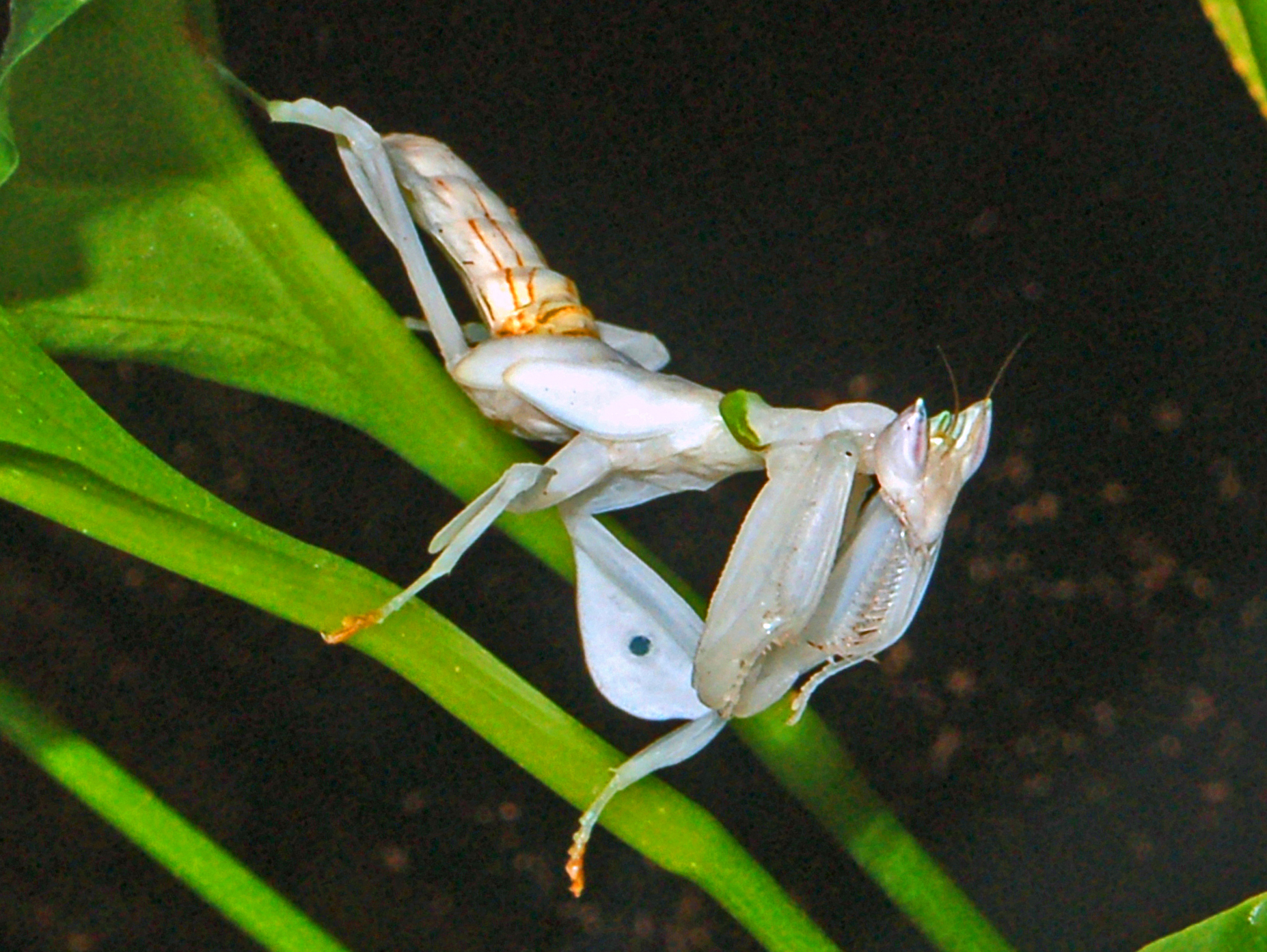
The orchid mantis employs a sophisticated hunting strategy that goes far beyond simple ambush tactics. These predators carefully select their hunting positions, often choosing locations where multiple flowers are clustered together. By positioning themselves among real blooms, they increase their chances of encountering prey while maintaining perfect camouflage.
The mantis demonstrates remarkable patience, sometimes remaining motionless for hours while waiting for the perfect opportunity. During this time, it continuously monitors its surroundings using compound eyes that can detect the slightest movement. When prey approaches, the mantis makes subtle adjustments to its position, ensuring optimal striking distance without breaking its floral disguise.
What’s particularly fascinating is how the orchid mantis adapts its hunting behavior based on prey size and type. For smaller insects like gnats and flies, it may remain completely still until the last moment. For larger prey such as bees or butterflies, it may make slight swaying movements that mimic flowers moving in the breeze, adding another layer of authenticity to its deception.
The Female Advantage

Sexual dimorphism in orchid mantises reveals another layer of evolutionary strategy. Female orchid mantises are significantly larger than males, often reaching lengths of 6-7 centimeters compared to the male’s 2-3 centimeters. This size difference isn’t just about reproduction — it’s about hunting efficiency and prey selection.
Larger females can tackle bigger prey, including substantial butterflies and even small birds or lizards that might visit flowers. Their increased size also makes them more convincing flower mimics, as they can better replicate the proportions of larger orchid blooms. Males, being smaller, typically focus on smaller prey and may actually be more mobile, allowing them to change hunting locations more frequently.
The size difference also affects their camouflage strategies. Females tend to remain in prime hunting locations for extended periods, while males may move between different flowers throughout the day. This behavioral difference helps reduce competition between the sexes and maximizes hunting success for both.
Habitat and Distribution
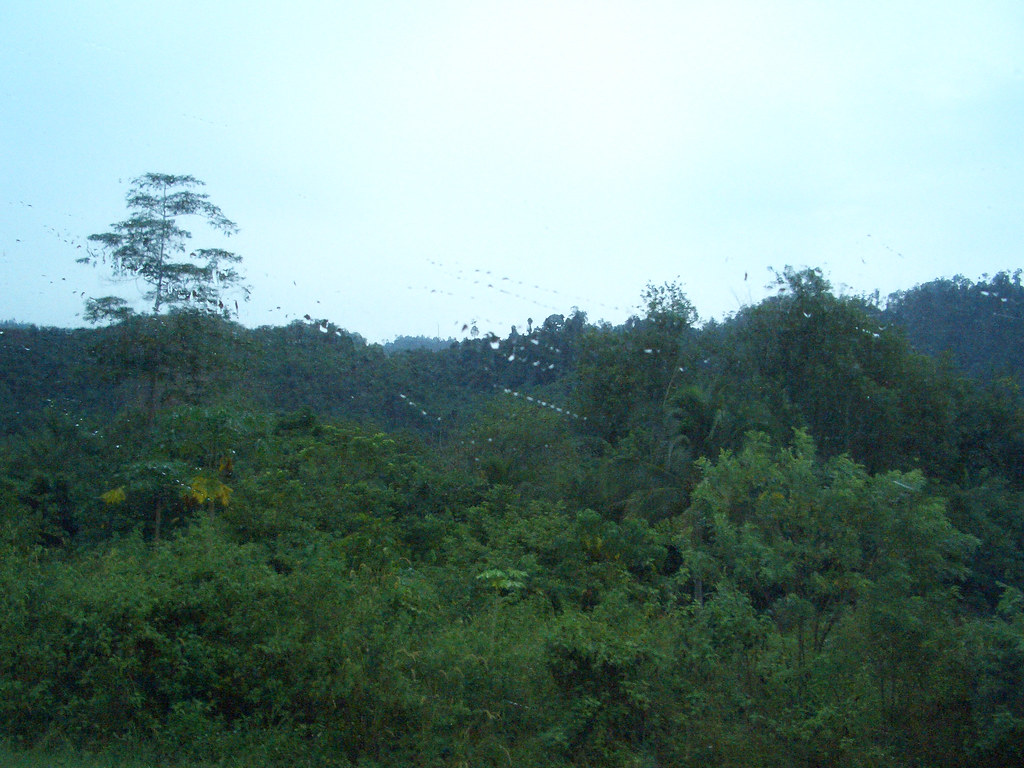
Orchid mantises are native to the tropical rainforests of Southeast Asia, including Malaysia, Thailand, Myanmar, and parts of Indonesia. These regions provide the perfect environment for their deceptive lifestyle, with high humidity, consistent temperatures, and an abundance of flowering plants. The dense forest canopy creates the dappled lighting conditions that enhance their camouflage effectiveness.
Within these forests, orchid mantises show strong preferences for specific microhabitats. They’re most commonly found in areas with high floral diversity, particularly where orchids, hibiscus, and other large, colorful flowers are abundant. The mantises seem to have an innate ability to select hunting locations that maximize their encounter rate with potential prey.
Climate change and deforestation pose significant threats to orchid mantis populations. As their natural habitats are destroyed or fragmented, these specialized predators lose both their hunting grounds and the flowers they depend on for camouflage. Conservation efforts are increasingly important for protecting these remarkable insects and their complex forest ecosystems.
Life Cycle and Development

The orchid mantis undergoes incomplete metamorphosis, progressing through egg, nymph, and adult stages. The transformation from tiny nymph to perfect flower mimic is a gradual process that takes several months. Newly hatched nymphs are already miniature versions of their parents, but their camouflage abilities develop progressively through each molt.
Young nymphs typically start with basic color patterns that provide some protection but lack the sophisticated petal-like structures of adults. With each successive molt, they develop more elaborate camouflage features, including the broadened leg segments and refined coloration that make adult orchid mantises so effective. This gradual development allows young mantises to hunt appropriate-sized prey while their disguise capabilities mature.
The molting process itself is particularly vulnerable for orchid mantises. During this time, they must shed their old exoskeleton while remaining hidden from predators. Many choose to molt in concealed locations away from their usual hunting spots, returning to their floral disguises only after their new exoskeleton has hardened and their colors have fully developed.
Prey Selection and Diet
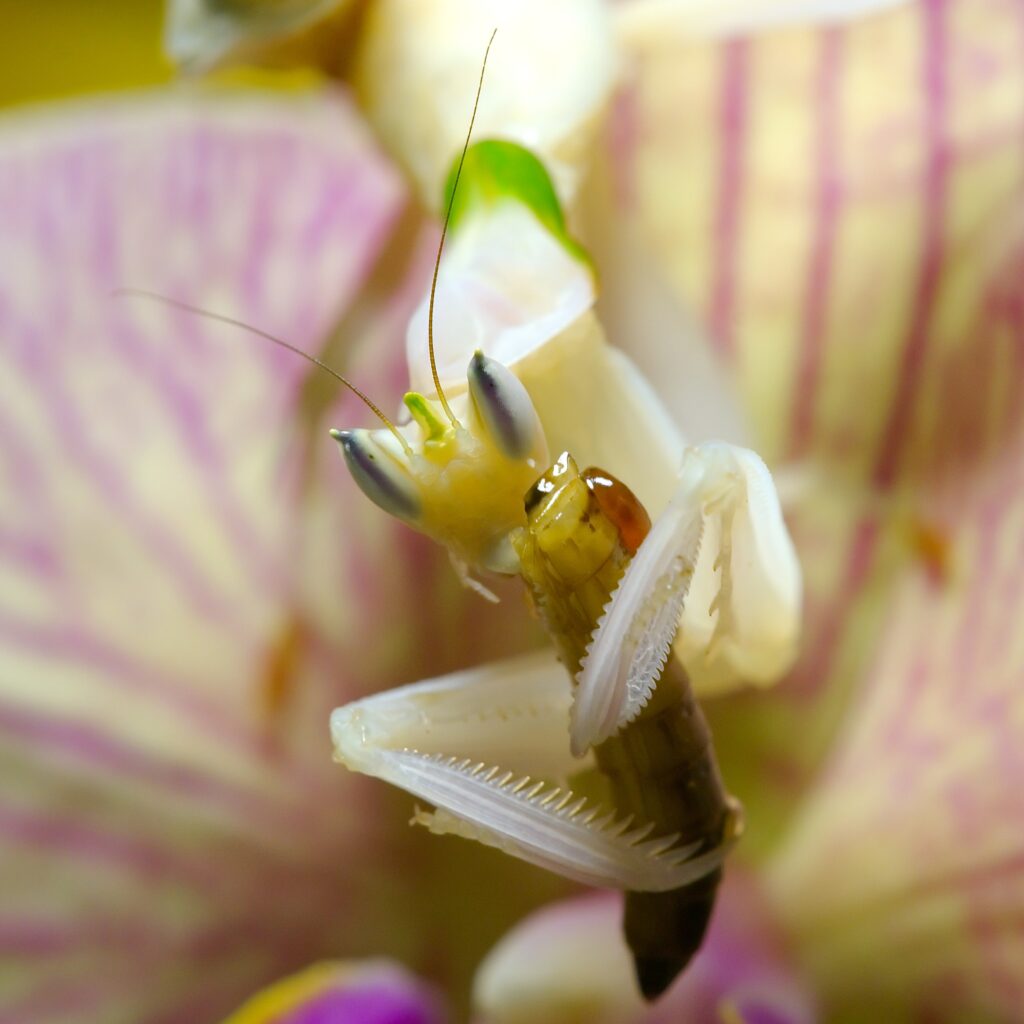
The orchid mantis’s diet reflects its specialized hunting strategy and floral mimicry. Flying insects make up the vast majority of their prey, with bees, flies, butterflies, and moths being primary targets. These insects are naturally attracted to flowers, making them perfect victims for the mantis’s deceptive strategy. The mantis shows remarkable selectivity, often ignoring prey that doesn’t fit its preferred size range or hunting conditions.
Interestingly, research has shown that orchid mantises are more successful at attracting prey than many of the real flowers they mimic. Their strategic positioning and optimal coloration make them irresistible to pollinators, sometimes attracting more visits than genuine flowers in the same area. This “super-stimulus” effect demonstrates how evolution can produce mimics that are more attractive than their models.
The mantis’s feeding behavior is methodical and efficient. After capturing prey, it typically begins feeding immediately, starting with the head to quickly dispatch its victim. The powerful mandibles can process even hard-bodied insects like beetles, while the mantis uses its forelegs to manipulate the prey during feeding. A single large prey item can sustain an adult mantis for several days.
Predators and Defense Mechanisms
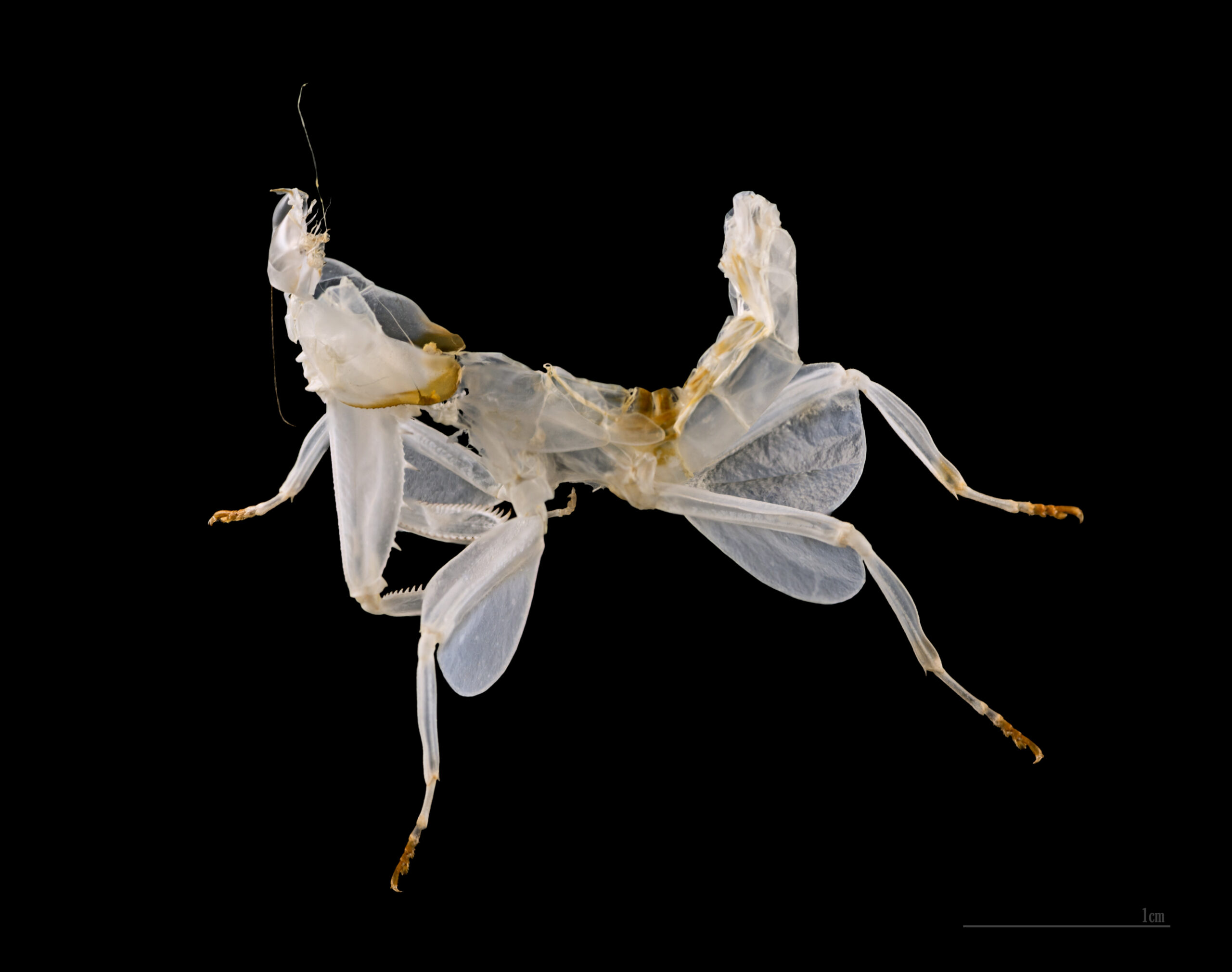
Despite their fearsome reputation as predators, orchid mantises face numerous threats from birds, spiders, and other insects. Their flower mimicry serves as their primary defense mechanism, but they have several backup strategies when their camouflage fails. When threatened, an orchid mantis may suddenly display its wings, revealing startling eyespots or bright colors that can startle potential predators.
The mantis can also employ intimidation displays, rearing up on its hind legs and spreading its forelegs wide to appear larger and more threatening. This behavior, combined with swaying movements, can make the mantis look like a completely different creature, potentially confusing predators long enough for escape. Some individuals have been observed dropping from their perches and playing dead when escape seems impossible.
Juvenile orchid mantises face additional challenges, as their smaller size and less developed camouflage make them more vulnerable to predation. Many young mantises adopt more cryptic behavior, spending more time in concealed locations and only emerging to hunt when conditions are optimal. This cautious approach helps them survive to adulthood despite their increased vulnerability.
Behavioral Adaptations
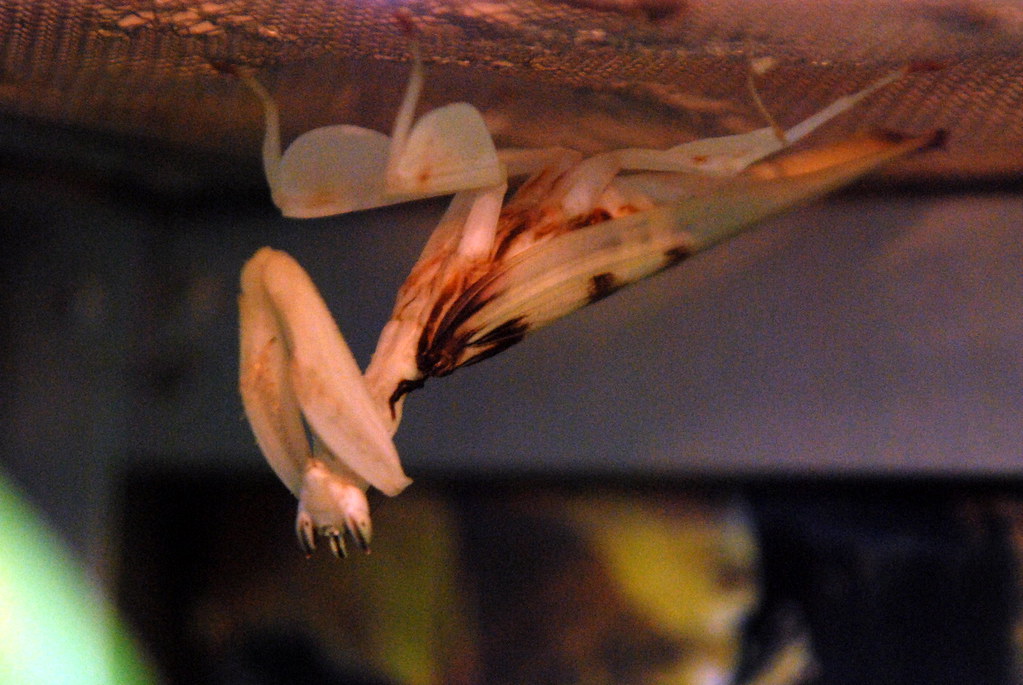
The orchid mantis exhibits sophisticated behavioral adaptations that complement its physical disguise. These insects demonstrate an understanding of optimal positioning, often adjusting their location throughout the day to maintain the most convincing floral illusion. They show preferences for certain times of day when lighting conditions best enhance their camouflage, typically being most active during the early morning and late afternoon hours.
Social behavior in orchid mantises is minimal, as these are primarily solitary hunters. However, they do exhibit interesting spacing behaviors, maintaining territories that ensure adequate hunting opportunities without direct competition. When multiple mantises are present in the same area, they establish a hierarchy based on size and hunting success, with larger individuals claiming the most productive hunting spots.
The mantis also shows remarkable learning abilities, adapting its hunting strategies based on experience. Individuals that have been successful in certain locations tend to return to those spots, while those that have encountered predators or unsuccessful hunting may relocate to new territories. This behavioral flexibility allows them to maximize their survival and reproductive success in changing environments.
Research and Scientific Study

Scientific research on orchid mantises has revealed fascinating insights into evolution, predator-prey relationships, and the limits of biological mimicry. Recent studies using advanced imaging techniques have uncovered previously unknown aspects of their camouflage, including how they manipulate light reflection and heat signatures to maintain their disguise. These findings have implications for understanding how complex adaptations evolve and function in nature.
Researchers have also investigated the cognitive aspects of orchid mantis behavior, discovering that these insects possess surprisingly sophisticated decision-making abilities. They can assess hunting conditions, evaluate prey quality, and make strategic choices about when and where to hunt. This research challenges traditional views of insect intelligence and suggests that complex behaviors can evolve in relatively simple nervous systems.
Current research focuses on understanding how climate change and habitat destruction affect orchid mantis populations. Scientists are studying their adaptation limits and developing conservation strategies to protect these remarkable insects. The research also explores potential applications of their camouflage mechanisms in developing new materials and technologies for human use.
Cultural Impact and Human Fascination
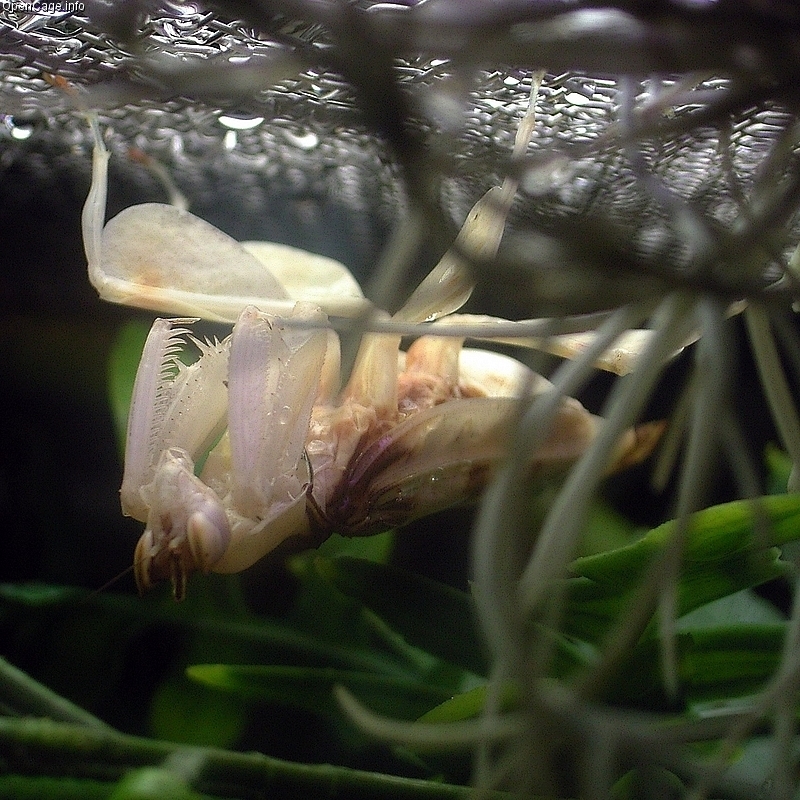
The orchid mantis has captured human imagination for centuries, appearing in folklore, art, and literature throughout Southeast Asia. Local cultures have developed various myths and legends around these mysterious creatures, often attributing magical properties to their flower-like appearance. Some traditions view them as guardians of the forest, while others see them as symbols of deception and hidden danger.
In modern times, orchid mantises have become popular subjects for nature photography and documentaries, helping to raise awareness about tropical biodiversity and the importance of rainforest conservation. Their striking appearance and fascinating behavior make them ideal ambassadors for insect conservation, showing people that even small creatures can be both beautiful and ecologically important.
The mantis has also influenced biomimetic research, inspiring scientists to develop new camouflage technologies and materials. Their sophisticated disguise mechanisms have potential applications in military camouflage, architectural design, and even fashion, demonstrating how studying nature can lead to innovative human technologies.
Conservation Challenges

Orchid mantises face increasing pressure from habitat loss, climate change, and human encroachment into their natural environments. The destruction of Southeast Asian rainforests directly threatens their survival, as these specialized predators require specific environmental conditions and flower communities to maintain their deceptive lifestyle. Fragmented habitats may not provide sufficient prey diversity or appropriate hunting locations for successful reproduction.
Climate change poses additional challenges, as rising temperatures and changing precipitation patterns can affect both the mantises and the flowers they depend on for camouflage. Changes in flowering times or flower abundance could disrupt the delicate balance that allows these predators to thrive. Conservation efforts must consider these complex ecological relationships when developing protection strategies.
International wildlife trade also presents risks, as orchid mantises are popular in the pet trade and scientific collections. While captive breeding programs can help reduce pressure on wild populations, they require careful management to maintain genetic diversity and ensure that captive populations could potentially contribute to conservation efforts in the future.
Conclusion
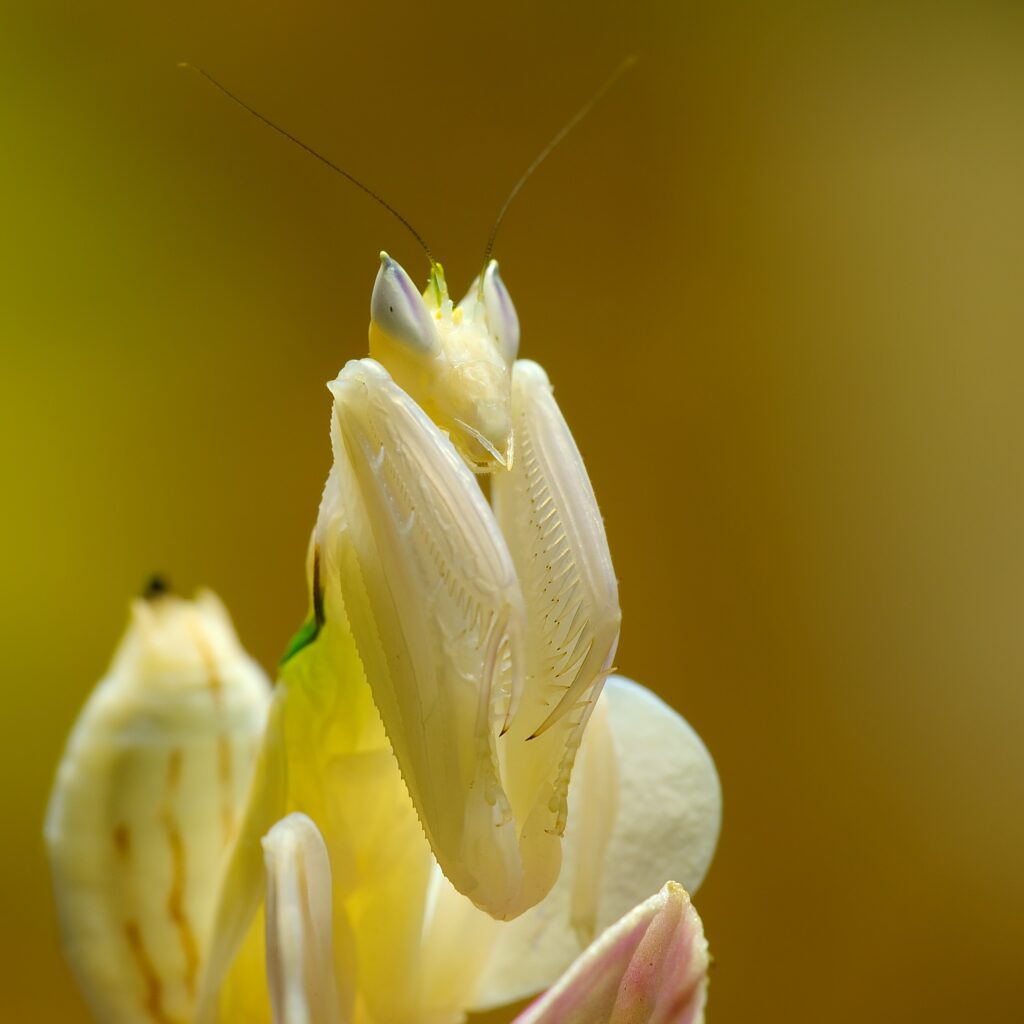
The orchid mantis stands as one of nature’s most extraordinary achievements, demonstrating the incredible power of evolution to create perfect biological deceptions. Through millions of years of refinement, this remarkable insect has become a living masterpiece of camouflage, combining physical beauty with deadly efficiency. Its sophisticated hunting strategies, complex behavioral adaptations, and perfect mimicry reveal the intricate relationships that bind ecosystems together.
As we face mounting environmental challenges, the orchid mantis serves as a powerful reminder of what we stand to lose if we fail to protect our planet’s biodiversity. These remarkable creatures represent not just individual species, but entire webs of evolutionary relationships that have taken millions of years to develop. Their survival depends on our commitment to preserving the complex forest ecosystems they call home.
The next time you see a beautiful flower swaying in the breeze, remember that nature’s greatest deceptions often hide in plain sight. In a world where appearances can be deadly, what other secrets might be waiting to be discovered in the shadows of the rainforest?

